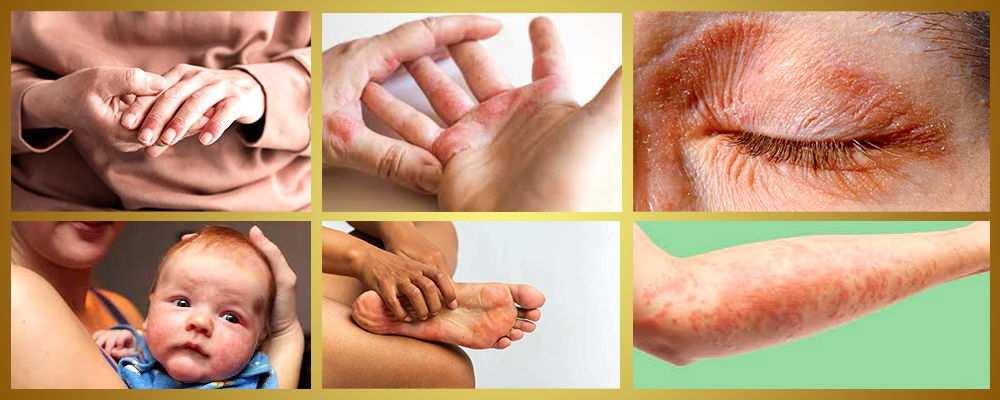Table of Contents
Eczema: Types, Symptoms, and Causes
Eczema is a common skin condition causing itchy rashes, dry patches, and skin irritation. The most common type, atopic dermatitis, often occurs with allergies like asthma or hay fever.
What Is Eczema?
Eczema is a common skin condition that causes itchiness, rashes, dry patches, and infections. It’s a type of dermatitis that inflames or irritates your skin, with atopic dermatitis being the most common type. “Atopic” means you’re more likely to also have allergies, like asthma or hay fever.
Most people manage eczema by getting treatment and avoiding irritants. Extreme itchiness is a key symptom, and scratching makes it worse.
Over 31 million Americans have eczema. Flare-ups, when symptoms get worse, can last for days or weeks.
Symptoms of Eczema

Eczema looks different for everyone, and flare-ups can happen in different areas. No matter where it appears, eczema is usually itchy. Your skin may be:
a. Red, dry, and cracked
b. Swollen with a rash (rash color varies by skin tone)
c. Bumpy (especially on brown or Black skin)
d. Thick and leathery
e. Oozing and crusting
f. Raw from scratching
Eczema rash:
Rashes look different for different people. On darker skin, it can be purple, brown, or gray, while on lighter skin, it can look pink, red, or purple.
Symptoms in infants:
In babies, the rash can ooze and crust, usually appearing on the face and scalp but also on the arms, legs, back, and chest. Symptoms can start in the first few weeks or months of life.
Symptoms in children:
Children and teens often get rashes in the bends of their elbows, behind their knees, or on their necks, wrists, or ankles. The rash becomes dry and scaly.
Symptoms in adults:
Adults usually get rashes on the face, behind the knees, wrists, hands, or feet. The skin may become dry, thick, and scaly. On fair skin, the rash might start red and then turn brown.
On darker skin, eczema can affect skin color, making the area lighter or darker. It can also appear as tiny bumps.
When to See a Doctor
Consult a healthcare provider if you or your child:
1. Shows symptoms of atopic dermatitis.
2. Experiences significant discomfort that affects sleep or daily activities.
3. Develops a skin infection, indicated by new streaks, pus, or yellow scabs.
4. Has persistent symptoms despite self-care efforts.
Seek immediate medical attention if there is a fever and the rash appears infected.
Causes
a. Genetics: A gene variation can weaken the skin’s barrier, making it less able to retain moisture and protect against irritants and bacteria.
b. Bacterial Imbalance: Overgrowth of Staphylococcus aureus can disrupt the skin’s natural bacteria, leading to symptoms.
c. Immune Response: A weak skin barrier might trigger inflammation.
Atopic dermatitis is one type of eczema, along with contact and seborrheic dermatitis. Dermatitis is not contagious.
Diagnosis
To diagnose eczema, your healthcare provider will:
1. Include your scratches.
2. look at your skin.
3. Check your medical history.
4. May be tested to diagnose acne and rule out other skin diseases. If you think a particular food may have triggered your child’s vomiting, ask about a possible food allergy.
Patch Test:
Your doctor may suggest a patch test. This involves applying small amounts of various products to your skin for coverage. Over the next few days, the doctor will monitor reactions to determine the specific allergens that are causing your allergies.
Treatments & Medications
Treatment and medication for eczema Effectively managing the symptoms of eczema or atopic dermatitis requires a multi-pronged approach. Here is a brief summary:
1. Topical Treatment
a. Moisturizer: Necessary to keep skin hydrated.
b. Topical corticosteroids: used to reduce inflammation during flare-ups.
c. Topical calcineurin inhibitors: non-steroidal alternatives for sensitive areas.
2. Drugs
a. Antihistamine: Helps with pain, especially at night.
b. Systemic Corticosteroids: Used temporarily for severe cases.
c. Immunosuppressants: For chronic, refractory eczema.
3. Phototherapy
a. UVB Therapy: Supervised exposure to UV light to reduce inflammation.
4. Biology
a. Dupilumab: biologic for moderate to severe cases when other treatments fail.
5. Life Tips
a. Avoid Triggers: Identify and remove known irritants.
b. Normal skin care: Gentle baths and frequent hydration.
A personalized combination of these treatments, under a healthcare provider’s guidance, can help manage eczema and improve quality of life.




